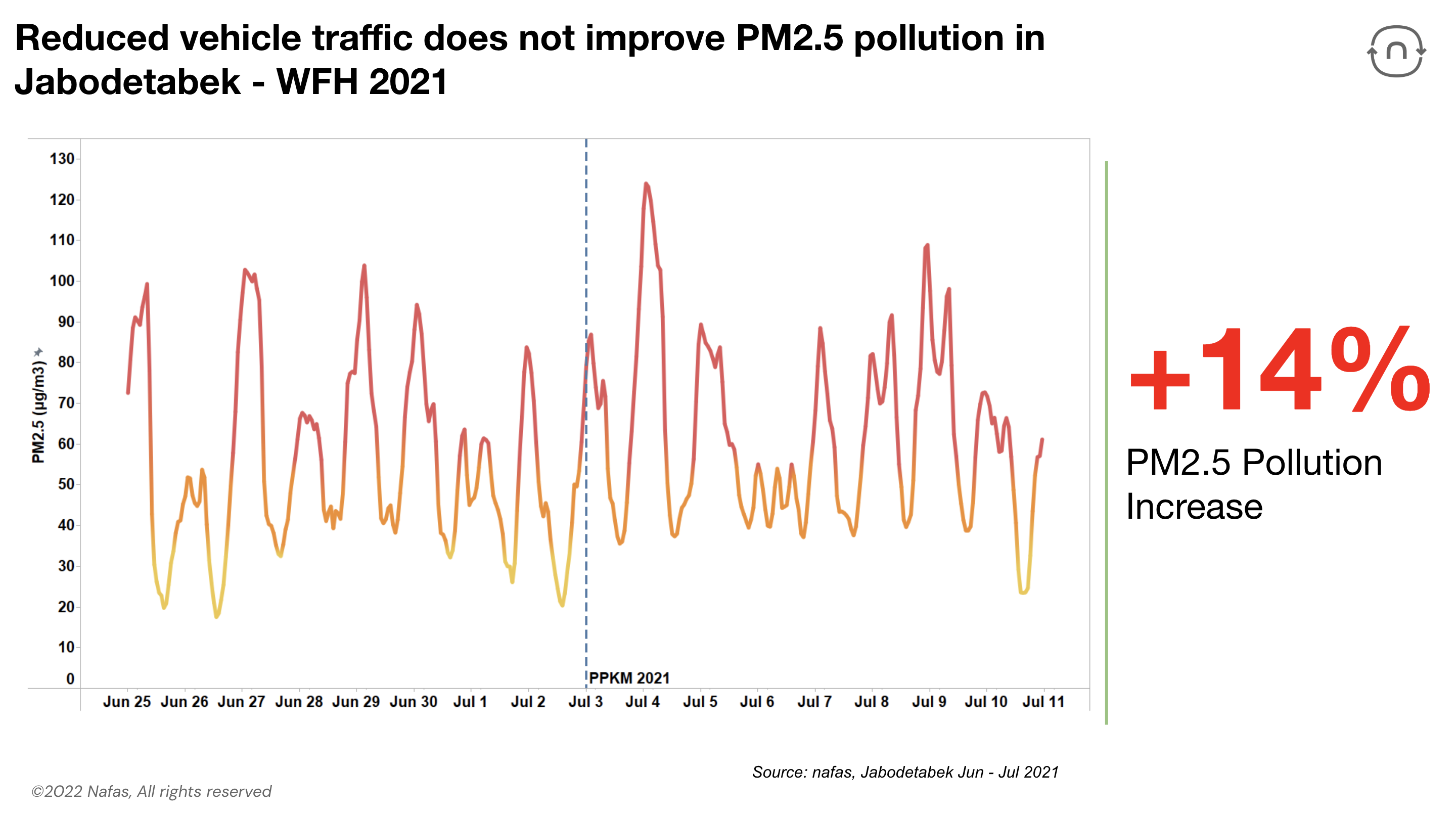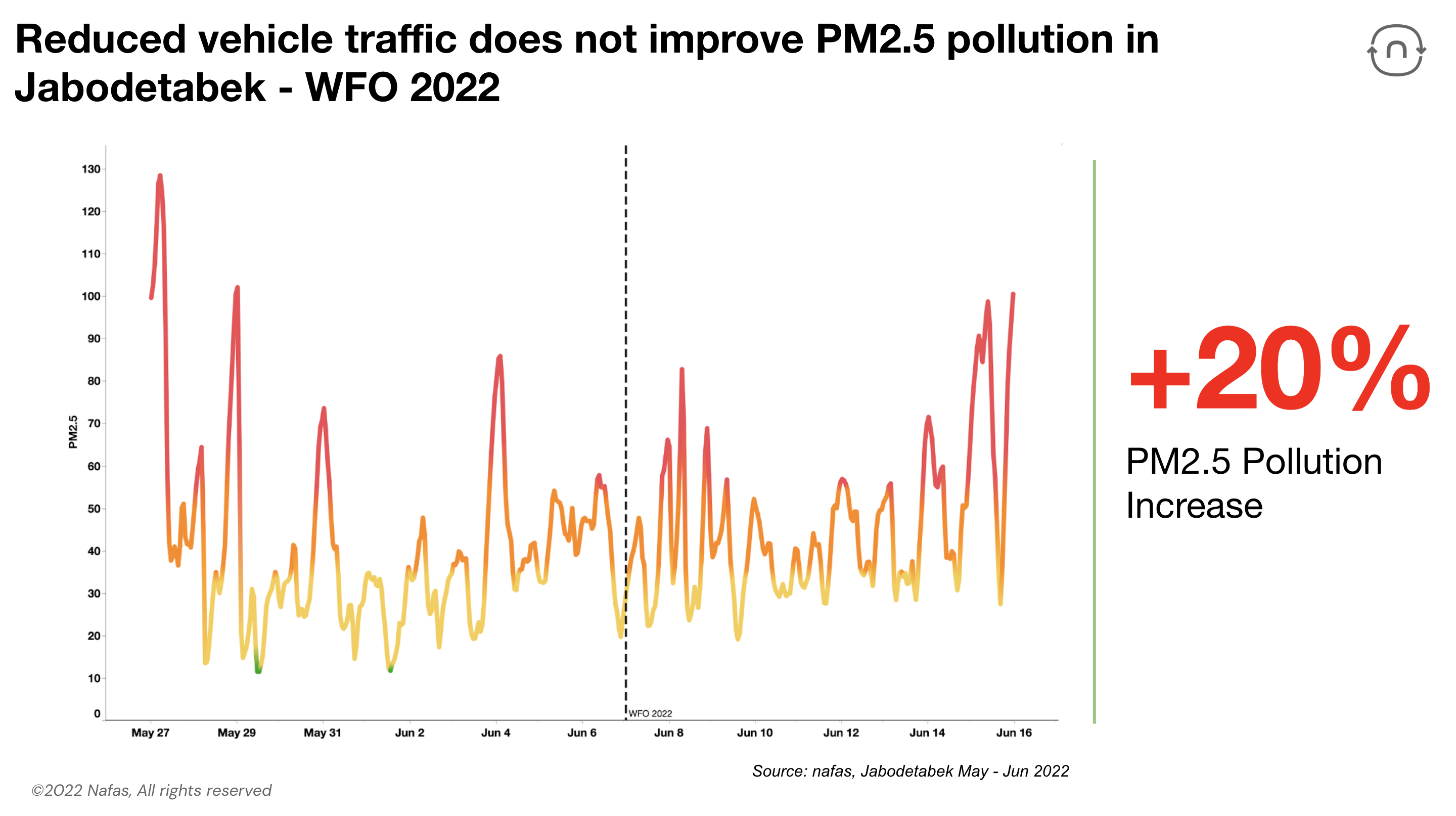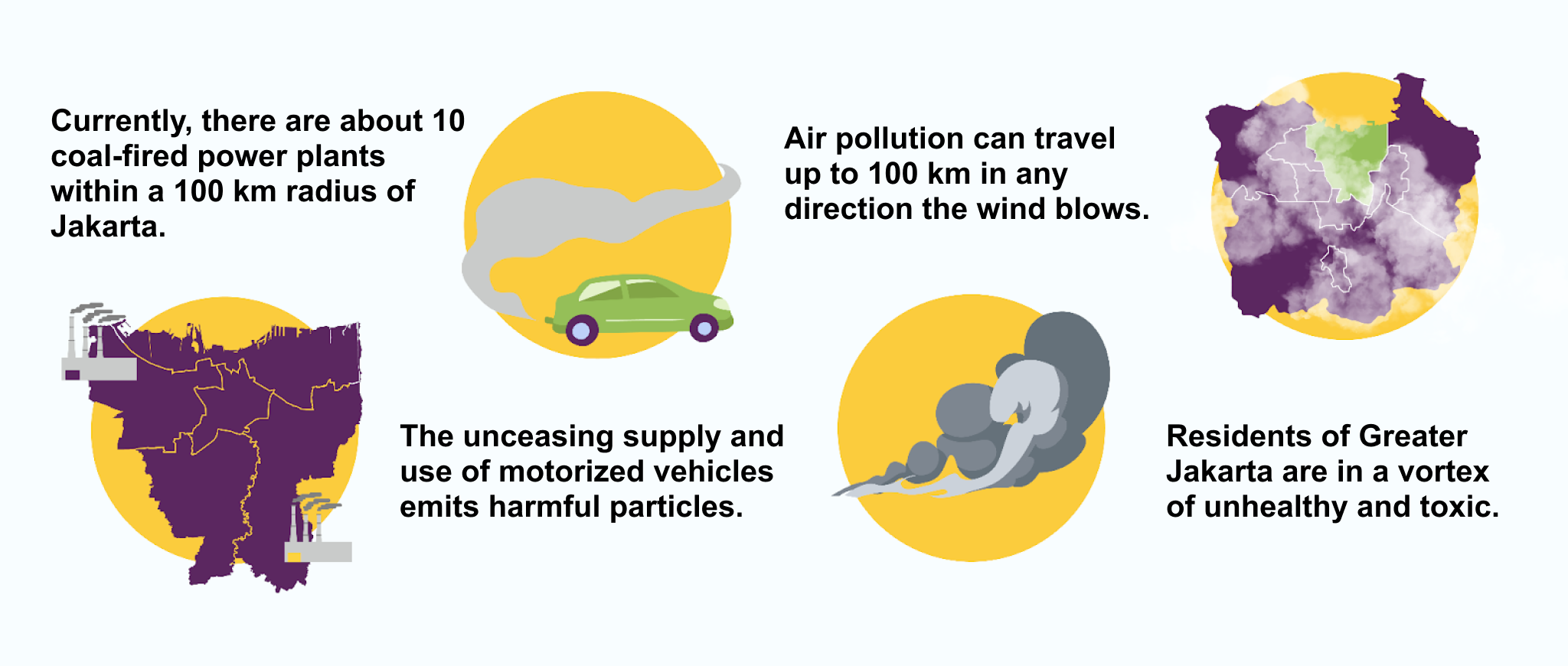WFH & WFO: Which causes the increase of pollution?
Many people still believe that traffic and transportation activities are the only sources of air pollution in Jabodetabek. Also, The Jakarta government has stated that transportation contributes to 60% of air pollution. Although several policies, such as the odd-even rule, have been pursued, the air quality in Jakarta is getting worse with no signs of improvement. Not only that, in June 2022, Jakarta often became the city with the worst air quality in the world.
Health risks due to air pollution
According to nafas data, PM2.5 levels in Jakarta reached 75.45 µg/m³ on June 15, 2022. This number is exceptionally high—it is 15 times the WHO annual air quality limit. PM2.5 exposure can cause short-term health effects such as irritation of the eyes, nose, throat, and lungs, coughing, sneezing, runny nose, and shortness of breath. In the long-term, exposure to these particles can affect a person's lungs and heart. Long-term exposure to PM2.5 is associated with an increase in the long-term risk of cardiopulmonary mortality by 6–13% per 10 µg/m³ of PM2.5.
Most recently, a study from Korea showed a 33% increased risk of heart disease when young adults aged 20-39 exercise above PM2.5 levels of 26.46 µg/m³. Other than that, a study from the US showed that moms with exposure to PM2.5 levels above 15 µg/m³ during their pregnancy had a 19% higher risk of premature birth.
Furthermore, employees in the non-essential and essential sectors are currently permitted to work from the office (WFO) at total capacity in Jakarta. As a result, human activity and traffic volume increase, causing more air pollution in the atmosphere.
But, does this actually worsen air quality compared to work from home (WFH)? I don't think so. Here’s why.
Throwing back to PPKM Darurat
On July 3, 2021, Pemberlakukan Pembatasan Kegiatan Masyarakat (or PPKM) Darurat was implemented to reduce social interactions and the spread of coronavirus. We all know that the COVID-19 pandemic has forced human and economic activities to freeze across the world and work from home (WFH), as it becomes truly globalized. However, some people are calling this pandemic a “blessing in disguise” — as lockdowns have drastically reduced air pollution.
“Transportation decreases, vehicle emissions decrease, air pollution decreases, ….and finally, air quality improves.” — Well, this thought may have crossed your mind.
But is it truly improve the air quality?
Sadly, no. 
Based on PM2.5 data measured by nafas sensors in Jabodetabek, the number of PM2.5 has increased by 14% since the PPKM Darurat was held.
Empty roads and lack of transportation during WFH do not improve air quality in Jakarta.
Work From Office era
As we’ve mentioned before, employees in Jakarta are now allowed to work from office (WFO) at total capacity. This means that human activities have returned to normal with increased traffic and the number of vehicles in the city.
Here is the data on PM2.5 concentrations measured by nafas sensors since the 100% WFO policy was implemented on June 7, 2022.
Based on PM2.5 data measured by nafas sensors in Jabodetabek, the number of PM2.5 has also increased by 20% since WFO was re-enacted.
Neither WFH nor WFO have reduced air pollution levels in Jakarta.
The increase in air pollution occurs even under these two conditions.
Car emissions are not the only source of air pollution in Jakarta
According to the Air Quality Life Index (AQLI) 2021 report, transportation in Jakarta accounts for around 31.5% of the city's PM2.5 pollution. Most of the air quality in Jakarta is affected by coal-fired plant pollution, factory fumes, and waste-burning smoke. These sources aren’t all come from Jakarta. Major contributors to the city’s PM2.5 pollution are the clusters of factories and coal power plants in the neighboring provinces of Banten, west of the capital, and West Java, to the east. Even so, meteorological factors such as wind direction and speed highly contribute to Jakarta's air quality. According to BMKG, these pollutants are then carried by the wind to Jakarta.

The importance of monitoring the air quality
It turns out that WFH and WFO policies do not always determine the air quality improvement in a location. Vehicles are not the only source of PM2.5 pollution. Industrial and meteorological factors also have a major influence on air quality. Although both vehicle emissions and human activity contribute to air pollution, it appears that other sources have a far greater impact than the two most common sources.
That is why nafas always recommends you check the outdoor air quality first before doing any outdoor activities. A proper facemask should be considered to reduce exposure to harmful air pollution.
Want to get started now? Click here to open your nafas.
References:
Air pollution and physical exercise: When to do more or less. ScienceDaily. https://www.sciencedaily.com/releases/2021/03/210329200307.htm
Beelen, R., Hoek, G., van den Brandt, P. A., Goldbohm, R. A., Fischer, P., Schouten, L. J., Jerrett, M., Hughes, E., Armstrong, B., & Brunekreef, B. (2008). Long-term effects of traffic-related air pollution on mortality in a Dutch cohort (NLCS-AIR study). Environmental health perspectives, 116(2), 196–202. https://doi.org/10.1289/ehp.10767.
Pope, C. A., 3rd, Burnett, R. T., Thun, M. J., Calle, E. E., Krewski, D., Ito, K., & Thurston, G. D. (2002). Lung cancer, cardiopulmonary mortality, and long-term exposure to fine particulate air pollution. JAMA, 287(9), 1132–1141. https://doi.org/10.1001/jama.287.9.1132.